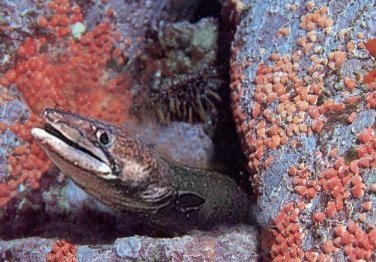 The conger eel is an elongated fish with a dorsal and anal fin, and they like the moray eel live in caves and rocky reefs.
The conger eel is an elongated fish with a dorsal and anal fin, and they like the moray eel live in caves and rocky reefs.
Congers have muscular, snake-like bodies. A large mouth with sharp conical (cone shaped) teeth. They have thick skin and no scales, but a layer of mucus covers the body and protects the skin from germs and parasites. They have slightly large eyes and small gill openings just in front of the fins.
The Conger also has a broad head, and distinctive tubular nostrils are evident on the snout.
I have been able to find out about three species in New Zealand waters.
They are.....
- The common conger: (Conger verreauxi) This one being the most common or wide spred.
- The Silver conger: (Gnathophis habenatus) This one is an olive grey colour on the top turning to lighter sides, turning to silver. It only grows to about 30 to 40 cm or a little over 14" long. It inhabits water down to a depth of about 100 mts or 300 feet.
- Swolenheaded conger: (Bassanago bulbiceps) These one is pinkish brown colour and pailer below. It grows about the same size as the Silver conger and can be found in depths of 500 mts or 1600 foot.
The common conger is sometimes called the southern conger because it is more common around the southern parts of the country.
It is a blue to blackish colour above, though sometimes it can be grey, and whitish below.
The dorsal fin starts above the tip of the pectoral fin about one quarter of the lengh fron the tip of the head.
They have one long dorsal fin that curves around and connects with the short caudal fin (tail fin).
They can grow to about 7' or 2 mts long, though the average length would be aroung 100 to 150 cm or 4 to 5 foot.
The conger relies on its sense of smell to locate prey such as octopus, small fish, and crabs. They are bottom feeders and are more than capable of catching live food. They will hole up in a wreck or rough ground and ambush lesser species.
Conger Eels favour very rough ground and inhabit deepwater wrecks, reefs and broken ground. In shallow waters Conger are mostly nocturnal feeders, but in depths of 60ft or 18 mts more they feed at any time.
Divers are occasionally fortunate enough to see a free-swimming conger eel, but typically the head is all that can be seen as the eel looks out from its hiding place. I personally have only seen them free swimming at night.
Despite their rather fierce look and reputation, congers are normally docile unless provoked.
The Conger eel has another eel around New Zealand that would look very similar, this would be the Moray eel.